Soft Switch
Pan with fried fish
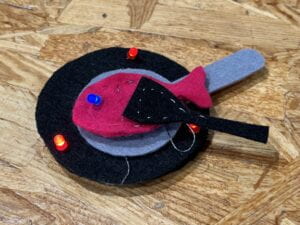 The soft circuit of mine is composed of 2 parts. The first part is a stove and a frying pan. When the pan is placed on the stove, 3 LED lights representing the fire are lit up. The second part is a fish and a spatula. When the spatula presses on the fish, the eye (a blue LED light) is lit up.
The soft circuit of mine is composed of 2 parts. The first part is a stove and a frying pan. When the pan is placed on the stove, 3 LED lights representing the fire are lit up. The second part is a fish and a spatula. When the spatula presses on the fish, the eye (a blue LED light) is lit up.
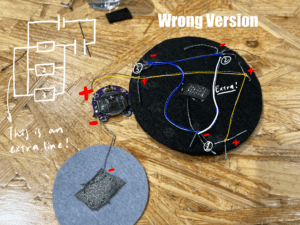
At the very beginning, I connected the 3 lights in series. Since the battery that I used was 3V (voltage), pointed out by Marcela, the voltage across each resistor was too low for the lights to light up. Under such circumstances, I should have connected the lights in parallel.
In series:
The current flow stays the same
The voltage is shared among components
In parallel:
The current flow splits in different connections
The voltage stays the same in different connections
I switched to connections in parallel, while only two out the three lit up. I was pretty sure that I connected the positives, and then connected the negatives. I cross checked my initial sketch and the circuit, and I eventually figured out that there was an extra conductive thread among the negatives. (when the thread was added, the current went through the thread with less resistance, thus there was no current though the light in the middle)
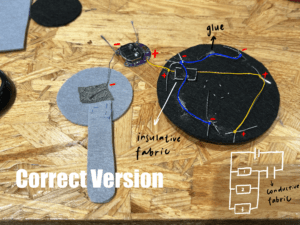
I cut the thread. Meanwhile, I added a few insulative fabrics between the threads that went across each other so they didn’t disturb the circuit.
Lacking knitting skills, I had to use the glue gun sometimes as I didn’t plan at the very beginning very well, so that it was very hard to knit when quite a few conductive threads and a battery were already tied with the lights. Nevertheless, I was glad that I made the 4 lights light up eventually, with a little interactive fun in this small set of toys.
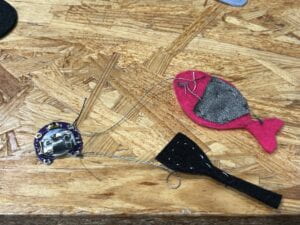
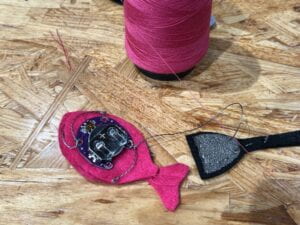
What is fashion for you? and why are you interested in fashion?
Fashion for me is about clothes with ideas. There’s a fashion cycle from the Haute Couture Week to the wardrobe of ordinary people, while I hardly agree that the those of the former should be deemed as more fashionable than the latter. Just because there is a process from pure social/artistic expressions to individual tastes and practical use, doesn’t mean that the ordinary can’t express their lifestyle and aesthetic through the medium of clothes.
While fashion can scarcely be a personal thing. Most of people rely upon trends under the present to express themselves. Some clothing trends that I oftentimes encounter on Chinese social media include Maillard, Dopamine, Old Money, All Grey, and so on, and there are tons of tutorials tutoring people on how to dress up like a certain style. I personally believe that what has differed the true meaning of fashion and chasing trends is the agency of one’s tastes. Knowing that what you wear speaks for yourself instead of for certain brands and trends in an attempt to mingle with the crowd, helps one regain their agency of their own body.
I can’t say that I’m fashion-conscious, but the interaction between clothes, accessory, and body interests me very much. What we wear and how we sense fashion can largely shape our personalities and social life. Just as Fred Davis points out in Fashion, Culture, and Identity, “our society is an ambivalent social world, characterized by tensions over gender roles, social status, and the expression of sexuality.” The culture forces behind fashion are what truly intrigue me and hope to learn about in this course.
What kinds of things do your clothing say about you and your values?
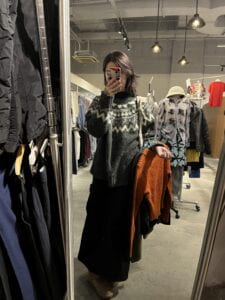
I don’t wear clothes with brand tags, not for the reason like Marcela’s (“promoting the brand”), but simply just because I don’t very fancy the seemingly uniform, sporty style of most of the brandy clothes (at least the brands within my affordability tend to be like this). I’d rather wear something comfortable yet that can manifest my personal taste. I attach a lot of importance on balancing how my body feels about the clothes and how the clothes look like, and only when there’s a fair balance there, I would feel much confident. I don’t like things that are unnatural, purely for decoration, making me feel insecure instead of comfy.
What are your main learnings and take aways from the readings?
1.the personal is the societal
What we assume as personal preferences, reflect deeper social and cultural forces. Forms, colors, textures, postures, and other expressive elements of a given culture, can be found in fashion. It is more of a response to the existing situation than a pure invention of new symbols.
2.clothes are context-based
The meanings of clothes can be largely dependent on the context. Here is an instance that I found quite interesting in the passage: the broad shoulder-inverted cone look in the mid-1980s: criticized by fashion-conscious socialites, liked by fashion elites as a kind of gender-inverted parody of military bearing, favored by career women as it seemed to distance them from unwelcome stereotypical inferences of feminine powerlessness, was found bizarre by housewives. The same set of clothes can be different to different people, and the code of visuals can be interpreted variously.
3.fashion resonates with the shifting collective tensions and moods abroad in society, imposing the changes on individuals through symbolic means, lending expression to individual identities.
